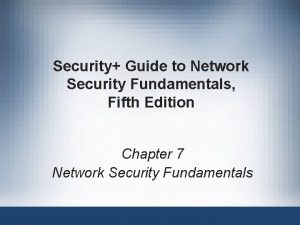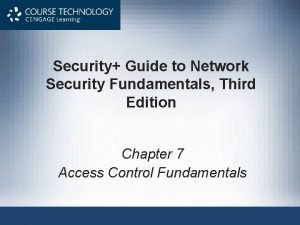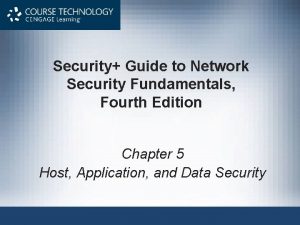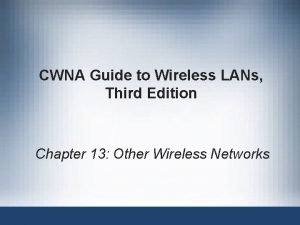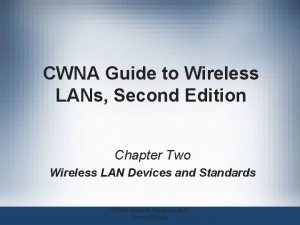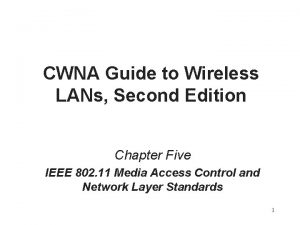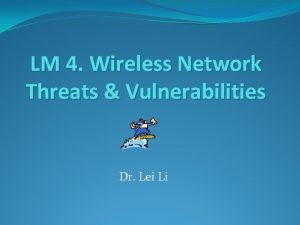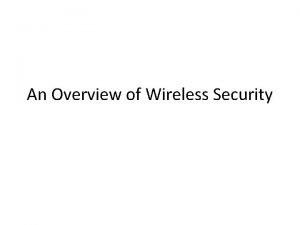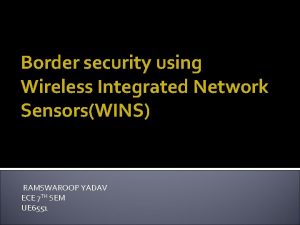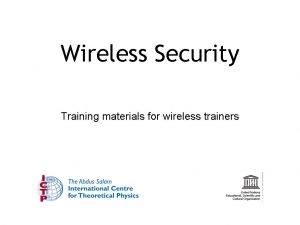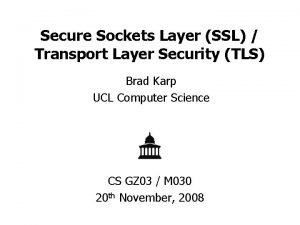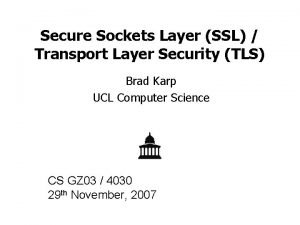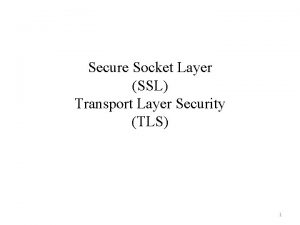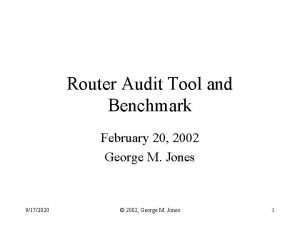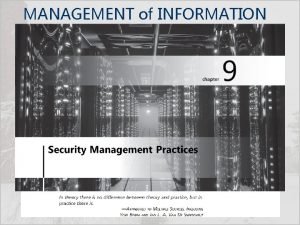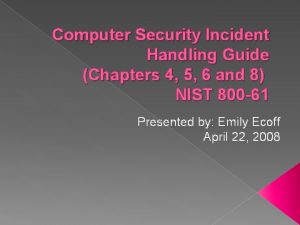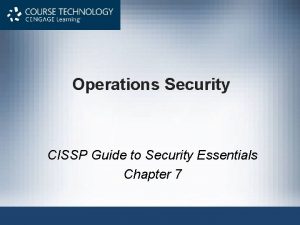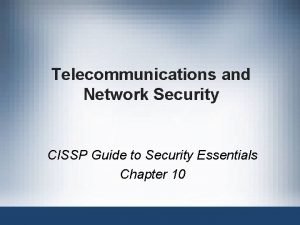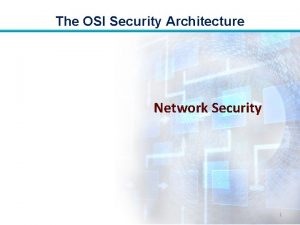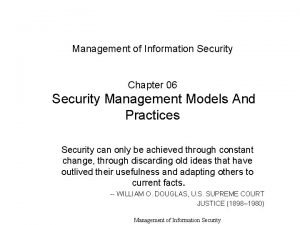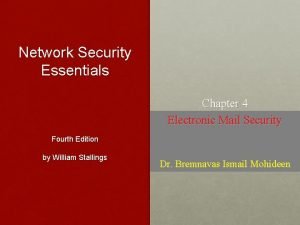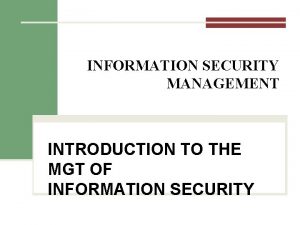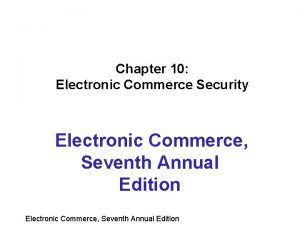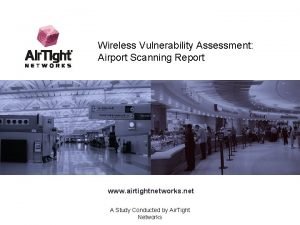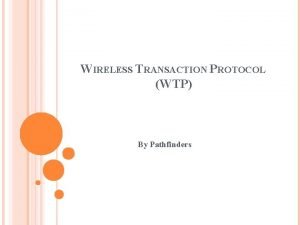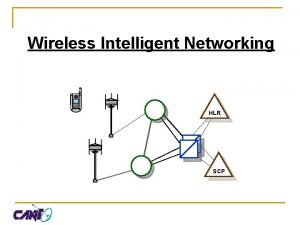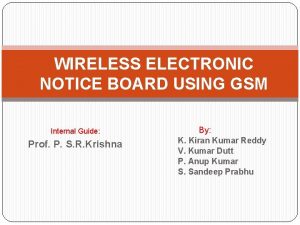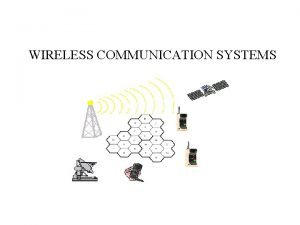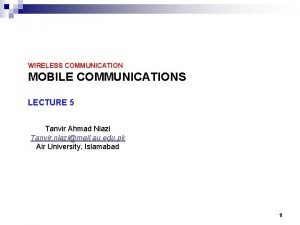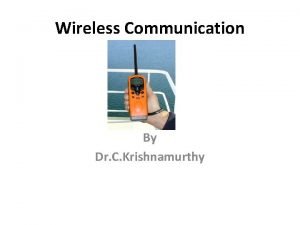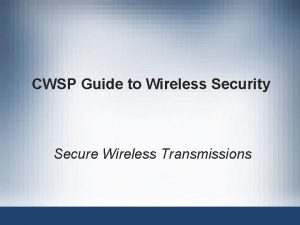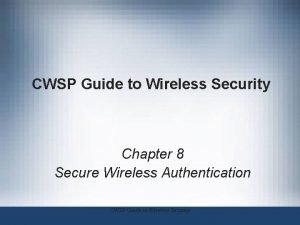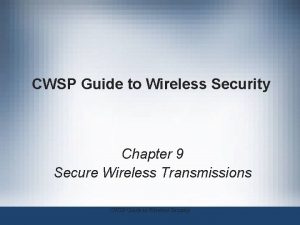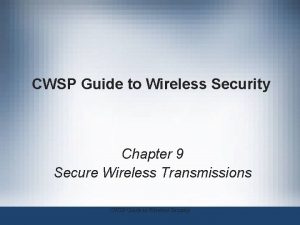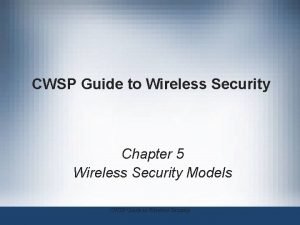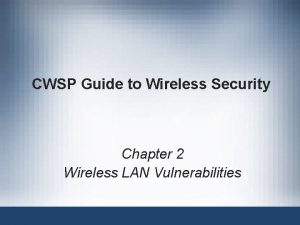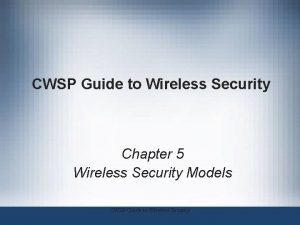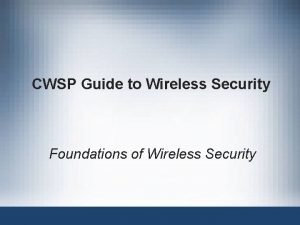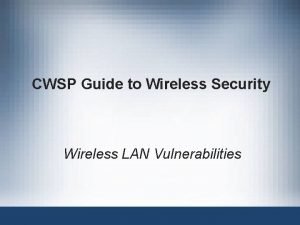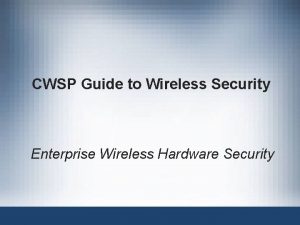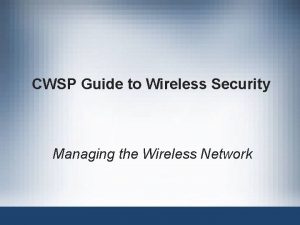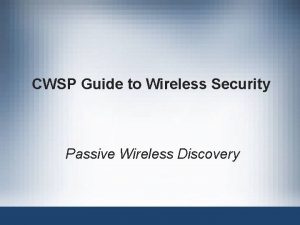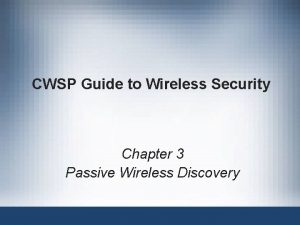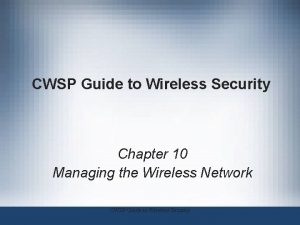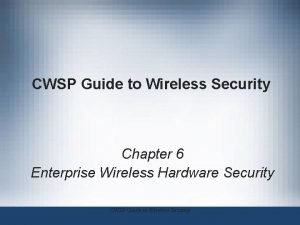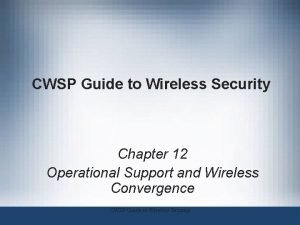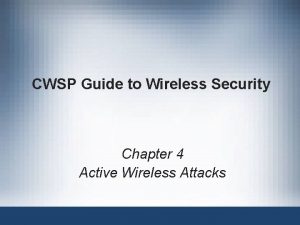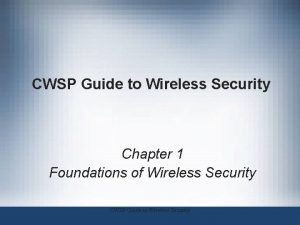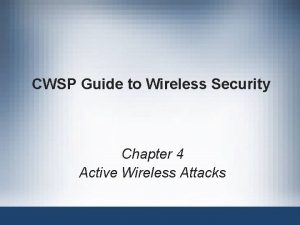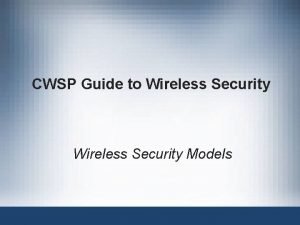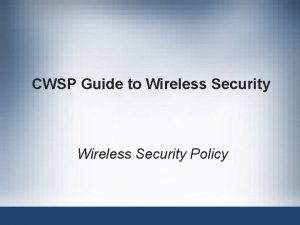CWSP Guide to Wireless Security Chapter 8 Secure


















































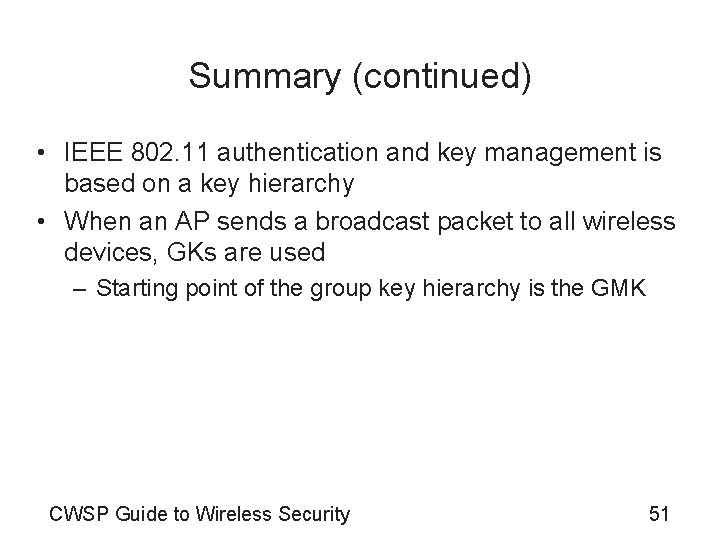
- Slides: 51

CWSP Guide to Wireless Security Chapter 8 Secure Wireless Authentication CWSP Guide to Wireless Security

Objectives • Define wireless authentication • List and describe the different types of authentication servers • Explain the differences between various extended authentication protocols • Describe IEEE 802. 1 i authentication and key management CWSP Guide to Wireless Security 2

Defining Authentication • It is important to understand exactly what authentication is – And the types of credentials that are used to authenticate users CWSP Guide to Wireless Security 3

What is Wireless Authentication? • Authentication – Users must give proof that they are authentic – Wired network devices are assumed to be authentic • Wireless authentication – Requires device to be authenticated before being connected to the WLAN • Types of wireless device authentication – Open system authentication – Shared key authentication CWSP Guide to Wireless Security 4

Authentication, Authorization, and Accounting (AAA) • Triple “A” elements – Authentication determines who the user is – Authorization determines what the user can do – Accounting determines what the user did • Authentication controls access by requiring valid user credentials • Authorization is the process that determines whether the user has the authority to carry out certain tasks • Accounting measures the resources a user consumes during each network session CWSP Guide to Wireless Security 5

Authentication, Authorization, and Accounting (AAA) (continued) • Information can be used: – To find evidence of problems – For billing – For planning • AAA servers – Servers dedicated to performing the AAA functions – Can provide significant advantages in a wireless LAN CWSP Guide to Wireless Security 6

Authentication Credentials • Categories of credentials – Something the user knows – Something the user is – Something the user has • Passwords – Fall into the category of something the user knows – Secret combinations of letters and numbers • Biometrics – Uses unique human characteristics for authentication CWSP Guide to Wireless Security 7

Authentication Credentials (continued) • Biometrics (continued) – Human characteristics commonly used • Fingerprints and unique characteristics of the face, hand, iris, retina, or voice • Digital certificates – Asymmetric encryption or public key cryptography • Private key is used to encrypt messages • Public key is used to decrypt messages – Electronic files used to uniquely identify users and resources over networks – Issued by a trusted third party (certification authority (CA)) CWSP Guide to Wireless Security 8

Authentication Credentials (continued) CWSP Guide to Wireless Security 9

Authentication Credentials (continued) CWSP Guide to Wireless Security 10

Authentication Credentials (continued) • Digital certificates (continued) – Registration authority (RA) • Handles some CA tasks, such as processing certificate requests and authenticating users – Information in a certificate • • • A serial number The holder’s public key The name of the certification authority The name of the holder and other identification info The start and stop date in which the certificate is valid CWSP Guide to Wireless Security 11

Authentication Credentials (continued) • Digital certificates (continued) – Can be used for authentication in a wireless LAN – Can also be used to provide encryption between the wireless device and the AP – Public Key Infrastructure (PKI) • System of using digital certificates, CAs, and other registration authorities – That verify and authenticate the validity of each party involved in a transaction over a public network • There currently is no single standard for using a PKI CWSP Guide to Wireless Security 12

Authentication Servers • Most common types – – RADIUS Kerberos TACACS+ Lightweight Directory Access Protocol (LDAP) CWSP Guide to Wireless Security 13

RADIUS • Remote Authentication Dial-In User Service – Developed in 1992 • For “high volume service control applications” – Such as dial-in access to a corporate network • RADIUS client – Dial-up server or wireless access point – Responsible for sending user credentials and connection parameters to a RADIUS server • RADIUS server – Authenticates and authorizes RADIUS client request CWSP Guide to Wireless Security 14

RADIUS (continued) CWSP Guide to Wireless Security 15

RADIUS (continued) • RADIUS servers (continued) – Can be used in conjunction with VLAN tagging for additional security • RADIUS allows a company to maintain user profiles in a central database – That all remote servers can share CWSP Guide to Wireless Security 16

Kerberos • Authentication system – Developed by the Massachusetts Institute of Technology (MIT) • Used to verify the identity of networked users • Kerberos authentication server – Provides a ticket to the user – Ticket contains information linking it to the user • User presents this ticket to the network for a service • Service examines ticket to verify user identity CWSP Guide to Wireless Security 17

Terminal Access Control System (TACACS+) • TACACS+ – Industry standard protocol specification – Forwards username and password information to a centralized server – Designed to support thousands of remote connections – Supports authentication, authorization, and auditing CWSP Guide to Wireless Security 18

Lightweight Directory Access Protocol (LDAP) • Directory service – Database stored on the network – Contains information about users and network devices • X. 500 – International Organization for Standardization (ISO) standard for directory services – White-page service • Looks up information by name – Yellow-pages service • Searches for information by category CWSP Guide to Wireless Security 19

Lightweight Directory Access Protocol (LDAP) (continued) • Information is in a directory information base (DIB) • Entries in the DIB are arranged in a tree structure called the directory information tree (DIT) – Each entry is a named object and a set of attributes • X. 500 standard does not define any representation for the data stored • Directory Access Protocol (DAP) – Protocol for a client application to access an X. 500 directory CWSP Guide to Wireless Security 20

Lightweight Directory Access Protocol (LDAP) (continued) • Lightweight Directory Access Protocol (LDAP) – Sometimes called X. 500 Lite – Simpler subset of X. 500 • Primary differences – LDAP was designed to run over TCP/IP – LDAP has simpler functions – LDAP encodes its protocol elements in a less complex way than X. 500 • LDAP makes it possible for almost any application in any platform to obtain directory information CWSP Guide to Wireless Security 21

Lightweight Directory Access Protocol (LDAP) (continued) • LDAP is often used in a WLAN in two different ways – Authentication server can use LDAP for retrieving user information – Many RADIUS servers support interfacing with an LDAP database CWSP Guide to Wireless Security 22

Authentication Design Models • Single site deployment – Simplest type of authentication model – Consists of one or more RADIUS servers accessing a centralized authentication database – Used when all WLAN users are located at a single site – Advantages • Only one authentication database to support • Fairly easy to increase the capacity of the single site – Disadvantages • Can be more difficult to scale as more users are added CWSP Guide to Wireless Security 23

Authentication Design Models (continued) CWSP Guide to Wireless Security 24

Authentication Design Models (continued) • Distributed autonomous site deployment – Uses local authentication with one or more RADIUS servers at each site – Authentication database is replicated from one central site to each local site – RADIUS servers actually perform the authentication and any accounting activity – Advantages • Does not rely on a remote network connection • Additional RADIUS servers can be added to remote site CWSP Guide to Wireless Security 25

Authentication Design Models (continued) CWSP Guide to Wireless Security 26

Authentication Design Models (continued) • Distributed sites with centralized authentication and security deployment – Rely on remote RADIUS servers for authentication – Management advantage • RADIUS servers and authentication database are all centrally located – Disadvantages • Depends on the reliability of the network connection • Bottleneck can occur if a large number of wireless users are supported CWSP Guide to Wireless Security 27

Authentication Design Models (continued) CWSP Guide to Wireless Security 28

Authentication Design Models (continued) • Distributed sites and security with centralized authentication deployment – RADIUS servers are located at each site to perform authentication – Authentication database is centrally located – Advantage • Mitigates the bottleneck problem – Disadvantage • Depends on the reliability of the network connection CWSP Guide to Wireless Security 29

Authentication Design Models (continued) CWSP Guide to Wireless Security 30

Authentication Design Models (continued) CWSP Guide to Wireless Security 31

Extended Authentication Protocols (EAP) • Extensible Authentication Protocol (EAP) – Management protocol of IEEE 802. 1 x – Governs the interaction between the wireless device, access point, and RADIUS server • EAP was designed with flexibility in mind – Different protocols can be used to support different authentication methods • And associated network security policies • Hashing (one-way hash) – Creates a ciphertext from cleartext – Used in a comparison for identification purposes CWSP Guide to Wireless Security 32

Extended Authentication Protocols (EAP) (continued) CWSP Guide to Wireless Security 33

EAP Legacy Protocols • No longer extensively used for wireless (or wired) authentication • Protocols include: – Password Authentication Protocol (PAP) • Basic authentication protocol – Challenge-Handshake Authentication Protocol (CHAP) • Foundation of CHAP is a three-way handshake – Microsoft Challenge-Handshake Authentication Protocol (MSCHAP) • Microsoft implementation of CHAP CWSP Guide to Wireless Security 34

EAP Weak Protocols • Still used but have security vulnerabilities with wireless networks • Protocols include: – Extended Authentication Protocol–MD 5 (EAP-MD 5) • Allows a RADIUS server to authenticate wireless devices stations – By verifying a hash (MD 5) of each user’s password – Cisco’s Lightweight EAP (LEAP) • Considered a step above EAPMD 5 CWSP Guide to Wireless Security 35

EAP Strong Protocols • Protocols include: – EAP with Transport Layer Security (EAP-TLS) • Requires public key cryptography such as digital certificates – EAP with Tunneled TLS (EAP-TTLS) and Protected EAP (PEAP) • Designed to simplify the deployment of 802. 1 x • Uses Windows logins and passwords instead of digital certificates CWSP Guide to Wireless Security 36

IEEE 802. 11 Authentication and Key Management • Once a user’s device is authenticated, the next step is to enable encryption • Encryption is based on a series of interrelated keys CWSP Guide to Wireless Security 37

IEEE 802. 11 Authentication and Key Management CWSP Guide to Wireless Security 38

Master Key (MK) • All other keys are formed from the master key • When using IEEE 802. 1 x: – MK is sent from the authentication server (usually a RADIUS server) to the authenticator (access point) • As part of an acceptance packet – MK is encrypted within an EAP packet – AP forwards this packet directly to the wireless device • Without seeing its contents CWSP Guide to Wireless Security 39

Pairwise Master Key (PMK) • Two ways for retrieving a PMK – In WPA or WPA 2 Personal security model • Preshared key (PSK) is entered by a user into both the access point and the wireless device • PSK is used in conjunction with the SSID to form the mathematical basis of the PMK – In WPA or WPA 2 Enterprise security model • PMK is generated by the RADIUS server and sent to the access point • Wireless device generates its own PMK CWSP Guide to Wireless Security 40

Pairwise Transient Key (PTK) • PTK is generated by combining the PMK with four pieces of data – – The supplicant’s (wireless device) MAC address The authenticator’s (access point) MAC address A nonce created by supplicant A nonce created by the authenticator • PTK is itself divided into three keys – Key confirmation key (KCK) – Key encryption key (KEK) – Temporal key CWSP Guide to Wireless Security 41

Pairwise Transient Key (PTK) (continued) CWSP Guide to Wireless Security 42

Pairwise Transient Key (PTK) (continued) CWSP Guide to Wireless Security 43

Group Keys • MKs are used for unicast transmissions • Group keys (GK) – Used for broadcast transmissions • Group master key (GMK) – Starting point of the group key hierarchy – Simply a random number • Group temporal key (GTK) – Created using the GMK, authenticator’s MAC address, and a nonce from the authenticator – Used to decrypt broadcast messages from APs CWSP Guide to Wireless Security 44

Group Keys (continued) CWSP Guide to Wireless Security 45

Handshakes • Handshake – Exchange of info between APs and wireless devices • Four-way handshake – Exchange of information for the MK – Accomplishes the following tasks: • Authenticates the security parameters that were negotiated • Confirms PMK between supplicant and authenticator • Establishes the temporal keys to be used by the dataconfidentiality protocol CWSP Guide to Wireless Security 46

Handshakes (continued) • Four-way handshake (continued) – Accomplishes the following tasks (continued): • Performs the first group key handshake • Provides keying material to implement the group key handshake • Group-key handshake – Authenticates the GTK – Preceded by the four-way handshake CWSP Guide to Wireless Security 47

Handshakes (continued) CWSP Guide to Wireless Security 48

Wireless Authentication and Encryption Summary • Based on the IEEE 802. 11 i security protocol – WPA Enterprise and WPA 2 Enterprise security models utilize IEEE 802. 1 x port-based authentication – Credentials used can be passwords, biometrics, and digital certificates – EAP manages port-based authentication – EAP-TLS, PEAP, and others are used for encryption • IEEE 802. 1 x – Provides the wireless device a unique encryption key called the MK • Used to create other encryption keys CWSP Guide to Wireless Security 49

Summary • Wireless authentication is the process of a device proving that it is “genuine” and not an imposter • Authentication servers are used to authenticate users in a WLAN – Most common type is a RADIUS server • EAP – Management protocol of IEEE 802. 1 x that governs the interaction between the wireless device, access point, and RADIUS server CWSP Guide to Wireless Security 50

Summary (continued) • IEEE 802. 11 authentication and key management is based on a key hierarchy • When an AP sends a broadcast packet to all wireless devices, GKs are used – Starting point of the group key hierarchy is the GMK CWSP Guide to Wireless Security 51
 Wireless security in cryptography
Wireless security in cryptography What are wireless devices and the wireless revolution
What are wireless devices and the wireless revolution Security guide to network security fundamentals
Security guide to network security fundamentals Security guide to network security fundamentals
Security guide to network security fundamentals Security guide to network security fundamentals
Security guide to network security fundamentals Provate security
Provate security Guide to wireless communications 4th edition
Guide to wireless communications 4th edition Cwna guide to wireless lans 3rd edition
Cwna guide to wireless lans 3rd edition Guide to wireless communications
Guide to wireless communications Cwna guide to wireless lans
Cwna guide to wireless lans Cwna guide to wireless lans
Cwna guide to wireless lans Wlan network
Wlan network Wireless security threats and vulnerabilities
Wireless security threats and vulnerabilities Wireless transport layer security
Wireless transport layer security 802-11-wireless-security
802-11-wireless-security Border security using wireless integrated network sensors
Border security using wireless integrated network sensors Wireless security training
Wireless security training Wireless security threats
Wireless security threats Secure socket layer and transport layer security
Secure socket layer and transport layer security Secure socket layer and transport layer security
Secure socket layer and transport layer security Secure socket layer and transport layer security
Secure socket layer and transport layer security Secure socket layer and transport layer security
Secure socket layer and transport layer security Cisco router assessment tool
Cisco router assessment tool Security performance management
Security performance management Computer security incident handling guide
Computer security incident handling guide Cissp guide to security essentials
Cissp guide to security essentials Cissp guide to security essentials
Cissp guide to security essentials Osi security architecture
Osi security architecture Explain about visa international security mode
Explain about visa international security mode Electronic mail security in network security
Electronic mail security in network security Cnss model 27 cells example
Cnss model 27 cells example Integrity in e commerce
Integrity in e commerce Software security building security in
Software security building security in Waites wireless
Waites wireless Wireless vulnerability assessment
Wireless vulnerability assessment Wtp wireless
Wtp wireless Air ionization in wireless power transmission
Air ionization in wireless power transmission Wireless power transmission project report doc
Wireless power transmission project report doc Wireless networking meaning
Wireless networking meaning Wireless intelligent networking
Wireless intelligent networking Wireless guest access solution
Wireless guest access solution Wireless electronic notice board using gsm
Wireless electronic notice board using gsm Wireless communication introduction
Wireless communication introduction Paging wireless communication
Paging wireless communication Cell dragging in wireless communication
Cell dragging in wireless communication Advantages of wireless communication
Advantages of wireless communication Replace crda with core/wireless-regdb
Replace crda with core/wireless-regdb Wireless presentation tco
Wireless presentation tco Wireless ecg machine project
Wireless ecg machine project What is grade of service
What is grade of service Naeapol
Naeapol Apakah artinya
Apakah artinya


